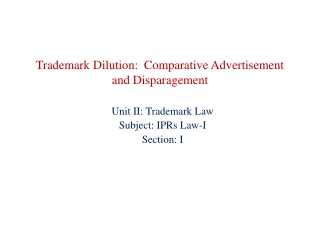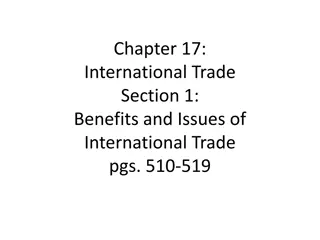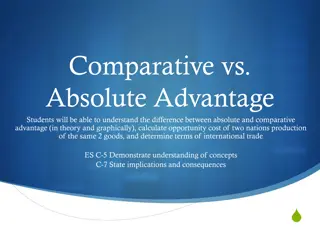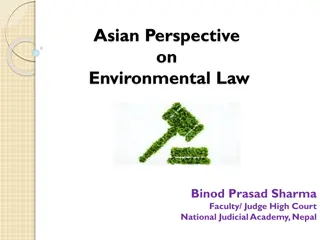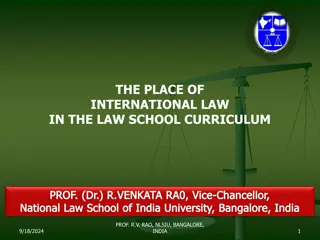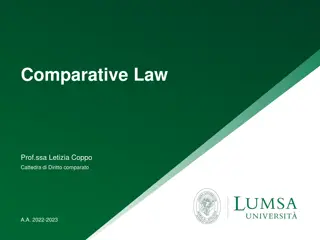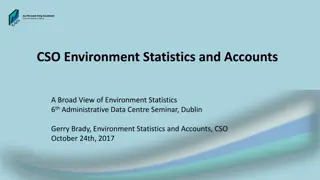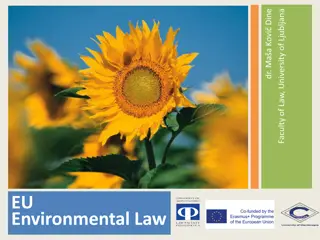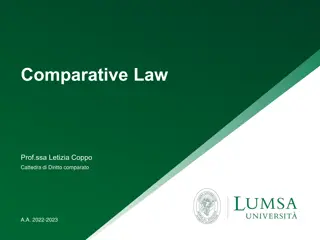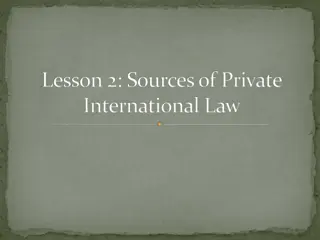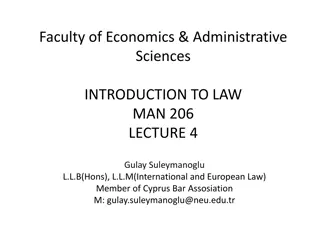Comparative and International Environmental Law Course Overview
Explore the world of Comparative and International Environmental Law with Dr. ukasz Prus through in-depth examinations, take-home exams, and insightful discussions on topics such as environmental policy, law sources, and regional systems. Dive into the complexities of waste management, common legal issues, and the essence of comparative law as a tool for global legal analysis and understanding.
Download Presentation

Please find below an Image/Link to download the presentation.
The content on the website is provided AS IS for your information and personal use only. It may not be sold, licensed, or shared on other websites without obtaining consent from the author. Download presentation by click this link. If you encounter any issues during the download, it is possible that the publisher has removed the file from their server.
E N D
Presentation Transcript
International and Comparative Environmental Law Dr ukasz Prus
Exam The exam will have a form of Take-Home Exam (homework) It can be case study related to the course I will send case study and questions. You have to prepare answers at home, library or in the reading room and send solutions to the teacher. To pass exam student should recognize the problem correctly, core of case study and describe it in his/her own words. To get B or A grade student has to justify her/his answers and opinions using good or very good arguments.
Exam You can prepare your essay about Environmental law and waste management in your country or international movements of waste at home or in the reading room and bring it at the term paper of last classes where we will discuss it. Each essay should consist of at least 2 pages but no more than 5 pages.
Course outline I. What is comparative law? What is International Environmental Law? Common Issues, Concepts and Definitions. II.Origin and development of environmental policy and law. III.Sources of international and regional (European) law. IV. General principles of international and European (regional) environmental law. V.Organization of environmental protection. VI.Selected issues from substantive law area. VII.Regional systems of environmental law.
Comparative law As Zweigert and Kotz (two famous comparative lawyers) claim: comparative law suggest an intellectual activity with law as its object and comparison as its process . The space, the territory is a key element of comparative law. The special dimension of law and comparison is that of internationalism. Thus comparative law is the comparison of the different legal systems of the world or analysis of foreign law.
Comparative law Any comparative approach has to take full account of the institutional context. For this reason, much work by comparative persons involves the study in depth of one other administrative system, which is then explained in terms familiar to those from the comparatist's own system
Comparative law The best of this work is explicitly comparative in terms of the questions asked about the other system and the explanations offered for the particular character of the system's development. Comparisons with more than one system are often less successful. If a single author undertakes such an enterprise, then it is often difficult for her or him to have an adequately deep understanding of how the governmental systems of all the different countries work.
Comparative law Comparatists often act like tourists who visit a foreign city and notice that things are different, be it to some extent similar too, compared to their home-town. After their visit they will be able to describe what they have seen to their family and friends at home Comparative researchers should become professionals rather than be tourists
Comparative law There comparative law. On the one hand, comparative law is regarded as a separate discipline jurisprudence and is treated as such. On the other hand, some academic recognize it exclusively as one of the methods of studying law. are two main approaches to of law and
Comparative law Comparative law is a specific method of studying law, with its own model of proceedings. It is about comparing specific elements and studying them in parallel in two or more systems of law. The tertium comparationis - the reason (motivation) and the basis of comparison - is function of given provisions. The main method of comparative law is called functionalism. The line of study is solely determined by the intention of the academic or legislator,or practitioner.One can focus on details (single rules, cases), on more general structures (as institutions of law, branches of law, systems of law), and finally on the most extensive issues like legal cultures or types of law. The essence of a specific problem is investigated with reference to other systems of law.
Comparative law You can compare specific public bodies (eg. environmental protection authorities) according to certain model. First of all you discuss one country, and later the second. In each country you analyze the same features (factors). So first in eg. Italy, you analyze, for example: position in the structure of public administration (including degree of dependence on the government, possibly independence); organization and structure; who can be the head (and employee) of such a body; public tasks and competences; judicial control of its activity.
Comparative law After that you analyze the same points (features) in eg. Poland. The idea is to compare the same features (factors). Thanks to this, it will be easier to obtain the result of the comparison (differences and similarities).
Comparative law Comparative law may be seen: -as the macro-comparison of the world s legal systems; -as the study of legal transplants, that is - of the borrowing of ideas between cultures and/or systems; -as the most fruitful way of exploring the relationship between law and society, and the underlying perceptions of law; -as the magnifying glass through which one best observes how state (domestic) law lives side by side with other sources of law (international or supranational).
Comparative law AIMS 1) CL as an instrument of learning and knowledge (information on the administration elsewhere and a better understanding thereof), 2) CL as an instrument of changes (If you know a foreign system, you can try using it in your country), 3) contributing to one s own administration system (understanding it better, including the resistance of its traditions, improving it, using it as a means for interpreting the constitution), 4) harmonization of administration, standards and law. Such research may be useful at the informative level, for businessmen for instance
Comparative law Other functions: 1/ as an aid to legislator, as a source of inspiration of lawmaking 2/ educational role of CL, as a part of university s education of lawyers 3/interpretative role of CL, especially helpful for courts and academics
Unification of law This function of comparative law dealt with its significant role in the preparation of projects of the international unification of law. The political aim behind such unification is to reduce or eliminate,so far as desirable and possible, the differences between the national legal systems by inducing them to adopt common principles of law.
Unification of law Method: to draw up a uniform law on the basis of work by experts in comparative incorporate it in a multilateral treaty which obligates the signatories, as a matter of international law, to adopt and apply the uniform law as their domestic law. Multilateral treaties are difficult to achieve and rather difficult in operation. law and to
Unification of law Other (alternative) method: to produce recommendation rather then of obligation) the most suitable method for the future, provided that they foundations of comparative law. model laws (this is a matter of are carefully drafted on the
Unification of law If the laws of two countries are identical, comparative law is pointless. That is why some academics claim that we are witnesses of the end of comparative law, and one of the reasons is (i.a) harmonisation and convergence of legal systems leading to creation of the European (or even global) legal (administrative) space.
Europeanization of law The term Europeanization of law' refers to certain types of interaction between European law and the internal law of member states as well as the influence of one on the other. Most often,we distinguish four types of such interaction: 1) Top-down Europeanization: this involves the unilateral (vertical) influence of European law on the internal laws of member states, 2) Bottoms-up Europeanization: The unilateral (vertical) influence of the laws of member states on European law, 3) Horizontal Europeanization: multilateral, mutual interaction between internal laws of European countries (based on European administrative law) , 4) Ad extra Europeanization: the influence of European law on non-European countries and in some cases, international organizations.
Europeanization of law As an effect of the process of the Europeanization, the relationship between redefined. The dividing line runs between the community of law (EU law) and the law of foreign countries (e.g the law of the USA). The moment a given state becomes a member of the EU,its internal laws cease to be 'foreign' in relation to other member states. law and territory is
Europeanization of law Europeanisation of international law as a new legal order of international law that imposes obligations and confers rights not only on states but also on their nationals/citizens/foreigners, EU environmental law provides additional legal means to ensure prompt and effective international environmental law at the EU and Member State level. By becoming part of the EU legal order, international environmental law acquires primacy over conflicting provisions of national law of the EU Member States. implementation of
Terminology Environmental law - body of rules [ ] concerned with the maintenance and protection of the natural environment of a country,http://www.businessdictionary.com International environmental international ecological law) is a field of international law which regulates the behavior of states and international organizations with respect to the environment. Essentially, international environmental application of public international law to environmental issues. European environmental law a regional regime of international environmental law treated as new legal order that imposed obligations and confers rights not only on states but also on their nationals. law (also known as law is the
Terminology Environmental law is a body of law, which is a system of complex and interlocking statutes, common law, treaties, conventions, regulations and policies which seek to protect the natural environment which may be affected,impacted or endangered by human activities. Environmental law - principles, policies, directives, and regulations enacted and enforced by local, national, or international entities to regulate human treatment of the nonhuman world. This vast field covers a broad range of topics in diverse legal settings (Encyclopedia Britannica,2008).
Terminology International environmental law is the study of the norms, means and processes to address global and regional environmental challenges. International environmental commodious, a reflection of interconnected ends that can be global, parochial and everything in between. It consists of a loose affiliation of treaties, principles and customs that define and describe norms, relationships and responses among and between states to meet many global ecological challenges. law is conceptually
Terminology The definition of the term environment is a key issue in environmental law. The broader the definition, the wider the field of environmental law. In order to substantiate the term, some legal orders define it comprehensively,while others do not.
Terminology Legal Environment means the entirety (whole) of natural elements, including those transformed by human activity; in particular, the earth's surface, soil resources, waters, atmospheric air, landscape, climate and other elements of biological diversity as well as the interaction among these elements (art. 3 p. 39 of the Environmental Protection Act). definition in the Polish system of law:
Terminology In the absence of an Environmental Law Code (Umweltgesetzbuch), the German legal order does not define the term environment . Environment in Germany at present means: - medial water,soil and atmospheric air; - vital humans,animals and plants; - natural-cultural landscapes; - objective certain material property,and - integrative the observance of the interaction between these components. This meaning is consistent with European Union environmental law. A general legal definition of the term environment in the Polish legal system almost exactly coincides with the one resulting from the interpretation of the term in the German legal order.
Terminology The English Environment Protection Act 1990,defines the environment as consisting of all, or any, of the [media] the air,water and land;and the medium of air includes the air within buildings and the air within other natural or man-made structures above or below ground .
Terminology The New Zealand Environment Act of 1986 environment as including: a) ecosystems and their constituent parts; b) all natural and physical resources; c) the social, economic, aesthetic and cultural conditions which affect the environment or which are affected by changes to the environment. defines
Terminology The EU law: Directive 2003/4/EC of the European Parliament and of the Council of 28 January 2003 on public access to environmental information Directive 90/313/EEC Art 2. 1.: Environmental information shall mean any information [ ] on: (a) the state of the elements of the environment, such as air and atmosphere, water, soil, land, landscape and natural sites including wetlands, coastal and marine areas, biological diversity and its components, including genetically modified interaction among these elements. and repealing Council organisms, and the
Terminology Directive 2011/92/EU of the European Parliament and Council of 13 December 2011 on the assessment of the effects of certain public and private projects on the environment Art 3: The environmental impact assessment shall identify, describe and assess in an appropriate manner [ ] the direct and indirect effects of a project on the following factors: (a) human beings,fauna and flora; (b) soil,water,air,climate and the landscape; (c) material assets and the cultural heritage; (d) the interaction between the factors referred to in points (a),(b) and (c). the
Terminology The necessity to observe the interaction between the single components of the environment is called internal integration, in opposition to the equal need for external integration. This means that environmental protection requirements must be integrated into the definition and implementation of other policies and activities, with a view to promoting sustainable development.
Terminology Principle 2 of Declaration of the United Nations Conference on the (Stockholm 1972) The natural resources of the earth, including the air, water, land, flora and fauna and especially representative samples of natural ecosystems, must be safeguarded for the benefit of present and future generations through careful planning or management,as appropriate. Human Environment
Terminology The legal approach to the environment is to separate regulations into broad categories. R Salter (European Environmental Law, 1994) has suggested three groups: 1/ Under a heading of natural environment, protection of environmental media is included. 2/ A second category is the manmade environment including the cultural heritage. 3/ A third category concerns human environment, including regulations on food content,products,safety issues,leisure and economic health (consumer protection, eco-labelling, and so forth). 4/ Further categories could environment, but in Salter s distinctions these should probably be treated as sub-categories o f a man-made environment. be indoor and working
Terminology Environment literally means surrounding and everything that affect an organism during its lifetime. Environment is sum total of water, air and land interrelationships among themselves and also with the human being, other living organisms and property . It includes all the physical and biological surrounding and their interactions. The term environment could be said to cover all those elements which in their complex inter-relationships form the framework, setting and living conditions for mankind, by their very existence or by virtue of their impact .
Environmental law or environmental protection law? In international environmental law is definitely predominant. This term is commonly used by various European countries systems of law. Poland? and European law the term
Environmental law or environmental protection law? Italy: Environmental law- a specialized branch of public (administrative) law dealing with the study of the sources of domestic, international and European law in the context of environmental protection and using environmental resources. Germany: numerous definitions relationship between environmental protection and sustainable development or form a concept of environmental protection primarily in terms of international law and European law. It is often recognized that the environment cannot be seen solely in terms of protection,but also in terms of its economic significance and utilization. emphasized in this context. pay attention to the Individual rights are also
Environmental law or environmental protection law? In Polish law the term environmental protection law is definitely predominant. The doctrine of Polish law, following the title of the fundamental legal act (the Environmental Protection Act of 27 April 2001), uniformly adopt the name environmental protection law .
Environmental law or environmental protection law? Using either of the two terms, the lawmaker reveals its vision of regulating environmental issues in the system of law. In environmental protection law the protective nature of a legal norm is emphasized, and at the same time the control and supervisory powers of public administration authorities are increased. In the case of environmental protection law the confrontation element is in the foreground and the lawmaker immediately advocates the environment.
Environmental law or environmental protection law? Although the system of Polish law traditionally uses the name environmental protection law in the language of law and the language of lawyers, the predominant elements are characteristic of environmental law conciliation elements with the principle of sustainable development at the forefront. Therefore, the name of this area of normative regulations should be reviewed and environmental protection environmental law . law should be renamed
Environmental law or environmental protection law? In the case of environmental law the predominant element is conciliation/balance, that is, the balancing (reconciliation) of conflicting values. The role of the authorities is not limited to control and supervision, but rather they should resolve conflicts between different values.
Terminology Policy of environmental protection a set of actions aimed at creating conditions necessary for the ensure of environmental protection, in accordance with the development (art. 13 of the Environmental Protection Act). principle of sustainable
Terminology According to art. 3 p. 13 of the Environmental Protection Act the term 'environmental protection' refers to action taken or refrained from in order to maintain or restore balance in nature. In particular,this protection entails: a) rational utilization of the environment and management of its resources in accordance with the principle of sustainable development, b) counteracting pollution, c) restoring natural elements to their original state.
Case Article 1 of Directive 75/442 provides: For the purposes of this Directive: (a) waste shall mean any substance or object in the categories set out in Annex I which the holder discards or intends or is required to discard 46
Case The Brussels-Capital Region owns a building at 132 avenue du Pont de Luttre in Brussels (Belgium). The renovation of that building which it had undertaken in order to set up a social assistance centre had to be halted on 18 January 1993 as the result of the discovery that water saturated with hydrocarbons was leaking into the cellar of the building from the wall which separates that building from the adjacent building at 134 avenue du Pont de Luttre, where a Texaco service station was at that time located. 47
The service station was covered by a commercial lease between Texaco and the owner of the premises Although disclaiming liability, Texaco proceeded to decontaminate (disinfect) the soil and replaced part of the storage facilities which gave rise to the hydrocarbon leak Whether soil contaminated (polluted) as the result of an accidental spill of hydrocarbons could be considered waste? Who is responsible for the problem? 48
The Courts reply Article 1(a) of Directive 75/442 defines waste as any substance or object in the categories set out in Annex I which the holder discards or intends to discard (throw out) The annex clarifies and illustrates that definition by providing lists of substances and objects which can be classified as waste Is not exhaustive list, closed list, numerus clausus 50


